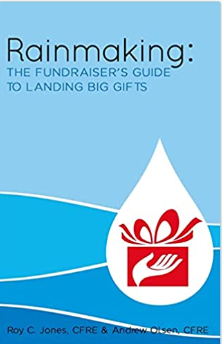Your board of directors can be your biggest asset. However, I have met with hundreds of presidents and executive directors of non-profit groups and the first thing they usually say is “my board is driving me crazy… what can I do?”
My answer is always the same, “Put Them To Work.”
Are your board members currently involved in major gift fundraising? If you are like most charities, your board members do not lift a finger to increase income, they only know how to do one thing, tighten the belt.
They make recommendations for saving money: changing suppliers; firing employees; cutting expenses, terminating programs. They are the types of moves people make when they do not understand the art of fundraising. This is the trap a board falls into. Board members want to demonstrate value without knowing how to increase revenues. So often, the solution is to just move the pieces around the chess board, without knowing how to raise any new money.
As the chief development officer you must empower your board with the knowledge for how to raise funds (even if they think they already know it all). You must create an environment that is focused on creating new revenue, instead of simply cutting the budget. Don’t get me wrong, I am not saying that you should never make cuts. What I am saying is that your focus has to be on creating new revenue and increasing overall giving.
What are the challenges?
Putting your board to work raising money is easier said than done. According to a recent survey by Boardsource.com, 68 percent of nonprofit organizations have a policy requiring board members to make a personal contribution on an annual basis. Boards average 74 percent participation in giving; however, on the average only 46 percent of boards had a 100 percent participation rate. In the arts and cultural organizations it is more common to find required annual contributions. [i]
You will never crack the code of board involvement by just requiring it. Board members have to see the need and the importance of their participation. You must ask yourself whether you really know what your board of directors believes about their position and responsibilities?
Board member giving is natural and necessary. Here are some other things that Boardsource.com says your board should consider. First of all, board members will raise more money personally if they are vested themselves in the organization. An appeal is particularly convincing if a board member uses him or herself as an exemplary donor. Your board should begin by writing a policy that requires all directors to participate in fundraising.
The board is responsible for providing a sound financial basis for the organization. By personally contributing, a board member recognizes this responsibility and demonstrates a commitment. Nearly 90 percent of American households contribute to charities. A board member should designate his or her own organization as one of the main recipients of his or her generosity.
Board participation can impact large gifts as well as annual fund gifts. Many foundations only contribute to organizations where every board member is a contributor. It is probably not a good idea to ask each board member to make an equal contribution. Some board candidates might find the amount too high; therefore the policy would eliminate valuable prospects from joining the board. Others may have considered contributing more but a lower suggested amount could change their minds. The policy could set a range, suggest a minimum amount and/or encourage each member to give generously according to his or her means. One set of guidelines may not be appropriate for every board.
You should encourage your board to draft a fundraising and personal giving policy. Your should recruit a leader on the board to drive the decision-making process. It does not need to be the board chair, but a sensitive peer who is in a good position to make the case and gain a consensus among board members. As the decision affects each board member individually, it is necessary to create a policy that can be enforced. To avoid any misunderstandings and false expectations, every board candidate should be familiar with these policies.
Once the policy has been adopted dedicate a portion of every meeting to discussing program on personal fundraising by the board. Board members need to be encouraged to build relationship with major donor prospects and piers who may one day make great board members. Their personal contribution to fundraising should not only be from their personal check book. It should also be from their activity in soliciting donations from piers and major donor prospects in the community.
Some boards ask their members to pledge a certain amount for the year or have them sign a letter of intent. The board chair or the chair of the development committee keeps track of the contributions and contacts any member who seems to have forgotten the pledge. Vigilant board chairs share the track records of individual board members with the rest of the board, thus increasing the ‘public’ pressure. When 100 percent of the board members have fulfilled their promises, the entire board celebrates. As long as there is a policy in place, there must be a method of making it work.
I encourage all not-for-profit boards to have an annual fundraising retreat or workshop for both senior staff and board members. The goal of this annual event is to make sure board members are equipped for the process of cultivating donor relationships. In addition, the directors should spend time reviewing prospect lists and identifying “ask ranges” for each opportunity. Most importantly, your event should culminate with every board member making two commitments: (1) the amount of money they will raise or donate personally in the upcoming year and (2) the number of individual meetings they will commit to attend with major donor prospects.
Nothing is more important that determining how many individual meetings your board and senior staff can do together. Remember, major gift development is not something that is done with mass marketing techniques. Building real relationships with donors will not happen on Facebook or by email or by a direct mail letter. Friendships are built only one way. They happen one-on-one, face to face.
The only way to expand your major gift program is to put more people on the job. Your board must make a commitment to meeting with your top major gift prospects. The question that your organization has to determine is “how many meetings can we do?” How many individual meetings can you do a year, a month or each business day?
The 50-10-3 Rule. I have written and spoken many times on the “50-10-3 Rule”. Remember, that you have to account for the time it takes to reach the donor by phone, mail or email in order to schedule a meeting. While this is a very broad generalization, I have always planned on talking to 10 people in order to schedule 2 to 3 visits. The real question then is what does it take to actually talk to ten people. In today’s market, dialing the phone over 50 times and leave about 20 voice mail messages is not unprecedented. Twenty voice mails (to 20 households) will result in reaching about half of them. If you talk to 10 people, only three will likely be able to meet the following week.
That’s right 50 phone calls in order to talk to 10 and meet with 3. It takes a lot of work. If you are like most not for profit executives you will now click back to your Facebook page and go back to your normal routine. However, if you are ready to roll up your sleeves and go to work… pick up the phone and start pounding out those phone calls. Your board of directors need to have a clear understanding of the 50-10-3 rule for scheduling visits with top prospects.


